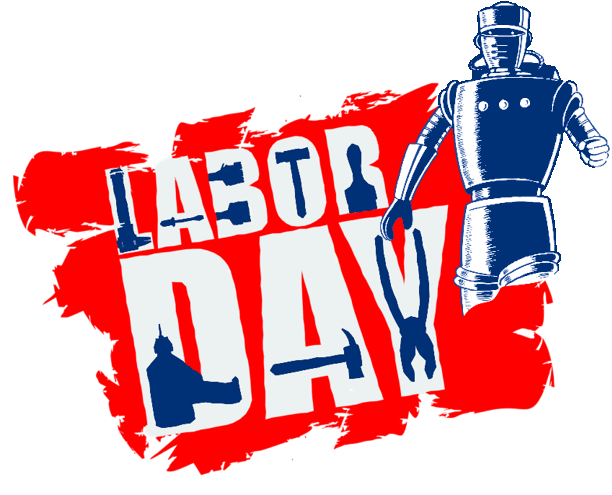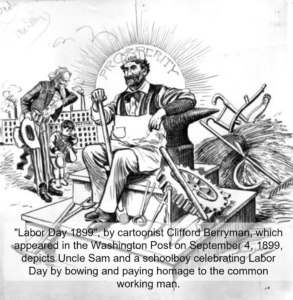This Labor Day greets us with a confusing employment situation as millions of people remain out of work at the same time a record number of job openings remain unfilled. Ben Popken (@bpopken) reports, “The civilian labor force participation rate, the government’s measurement of those who are working or unemployed but actively seeking work, remains dented, having only recovered by about half [when compared to the pre-pandemic rate].”[1] With so many people still out of work, one has to ask: Why are so many jobs going unfilled? Numerous experts have tried to explain the causes of this conundrum and, it’s fair to say, no single factor can explain the current, complicated situation. Popken reports, “[Some employers say] economic impact payments, or stimulus checks, have played a factor for some who are sitting out the labor market. … Factory owners and employers lament that the generosity of unemployment benefits and stimulus payments have some workers avoiding returning to work because they make more money not working.” Rather than raise employee pay to entice people back to work, employers have convinced some politicians to cut back economic impact payments to try and force people back to work. Jack Kelly (@wecruitr_io), founder and CEO of WeCruitr, observes, “It’s reasonable that if employers need workers so badly, they should raise pay. This is also not happening. ADP chief economist Nela Richardson said, ‘The full sentence is “I can’t find workers at the wage I am willing to offer.” Full stop.’ Richardson contends that if you pay them well, ‘you can find workers.’”[2]
Those explanations don’t take into account the continuing difficulty some parents are having trying to find childcare, the fear of contracting Covid-19 in crowded workplaces where vaccinated and unvaccinated workers must mingle, or a growing trend of people simply not wanting to fill jobs in certain fields, like retail and the food industry. Journalists from the Washington Post observe, “From the White House to the local Waffle House, there’s a struggle to understand what is going on — and what’s likely ahead.”[3] They offer a fuller and more nuanced explanation for the current situation they call the “great reassessment.” They elaborate:
“At heart, there is a massive reallocation underway in the economy that’s triggering a ‘Great Reassessment’ of work in America from both the employer and employee perspectives. Workers are shifting where they want to work — and how. For some, this is a personal choice. The pandemic and all of the anxieties, lockdowns and time at home have changed people. Some want to work remotely forever. Others want to spend more time with family. And others want a more flexible or more meaningful career path. It’s the ‘you only live once’ mentality on steroids. Meanwhile, companies are beefing up automation and redoing entire supply chains and office setups.”
As they note, in some cases, employers are turning to alternative strategies to replace missing workers. For example, tech journalist Christopher Mims (@mims) reports, “In a White Castle just southeast of Chicago, the 100-year-old purveyor of fast food has played host for the past year to an unusual, and unusually hardworking, employee: a robotic fry cook. Flippy, as the robot is known, is no gimmick, says Jamie Richardson, a White Castle vice president. It works 23 hours a day (one hour is reserved for cleaning) and has operated almost continuously for the past year, manning — or robot-ing — the fry station at White Castle No. 42 in Merrillville, Ind.”[4]
In the supply chain field, warehouses are being filled with an increasing number of robots to help keep up with the demands of e-commerce. Even in highly mechanized manufacturing plants, robotics and automation are increasingly replacing workers. Greg Ip (@greg_ip) and Angus Loten (@angusloten) report, “Robotics and artificial intelligence were already performing a growing range of tasks more cheaply and reliably than humans. With the pandemic, they demonstrated another advantage: They don’t spread the virus. One company that learned this lesson was Stanley Black & Decker Inc., which invested heavily in systems of autonomous robots in the months before the pandemic.”[5] They go on to note, “The original goal was to cut costs and boost output to better compete with a rising number of tool manufacturers in Mexico, he said. But the pandemic highlighted another benefit. Many manufacturers had to shut down factories and reorganize to space out workers. For Stanley, the robotic systems, made by Rockwell Automation Corp. for a total of $1.5 million, kept the South Carolina plant from shutting down at the height of the outbreak.”
A few years ago, the U.S. Department of Labor website explained, “Labor Day, the first Monday in September, is a creation of the labor movement and is dedicated to the social and economic achievements of American workers. It constitutes a yearly national tribute to the contributions workers have made to the strength, prosperity, and well-being of our country.” Many pundits fear the pandemic will hasten implementation of automated systems and put millions of people permanently out of work. The Economist notes, “Anecdotes abound of robots being brought in to reduce risks of infection, from automated slaughterhouses to do-it-yourself baggage drop-offs at airports. This wave of automation, some fear, will eliminate jobs, especially for those with less marketable skills, meaning more unemployment and inequality.”[6] If that happens, future Labor Day celebrations could be a time to reflect back on a bygone era when people actually held jobs now being done by robots and automated processes.
According to the Economist, however, evidence of a jobless future for humans is difficult to find. The magazine notes, “Luddites in early-19th-century Britain smashed up textile machinery for apparently putting them out of work. In 1928 the New York Times proclaimed that the ‘march of the machine makes idle hands’. In 1961 Time magazine talked of ‘the automation jobless’. A paper in 2013 by Carl Benedikt Frey and Michael Osborne, of Oxford University, was widely misinterpreted as meaning that 47% of American jobs were at risk of being automated. Yet such fears were not realized.” Nevertheless, the future will be one in which humans and machines work ever more closely together.
Aaron Klein (@Aarondklein), a Senior Fellow in Economic Studies at the Brookings Institution, believes we will be celebrating the contributions of human labor for the foreseeable future. He explains, “In 1930 over 67,000 Americans, were elevator operators. In 1910 there were over 167,000 telephone and telegraph operators. These jobs are handled primarily by robots now. Elevator operator has even been eliminated as a job classification. Yet, we have a world with many more phones and elevators and yes, total jobs. This creative destruction whereby new technology first creates jobs, then displaced them with future automation, has not resulted in the end of work, or even the end of quality work.”[7] He adds, “Not every robot that comes to take your job succeeds. In fact, some become your co-worker.”
Some experts, like American entrepreneur Andrew Yang (@AndrewYang), who styles himself a “Champion of a Human-Centered Economy,” believe the past pattern of jobs being lost to technology only to witness more jobs being created no longer holds true. Yang explains, “Automation doesn’t just affect millions of factory workers and truck drivers. Bookkeepers, journalists, retail and food service workers, office clerks, call center employees and even teachers also face the threat of being replaced by machines. These are some of the most common jobs in America. According to the Council of Economic Advisers in 2016, 83 percent of jobs paying less than $20 per hour could have substantial parts of their work given over to automation. And advanced degrees won’t protect you from this threat — doctors, accountants, and even lawyers face the same risk.”[8]
Is there cause for concern? Of course. Is the future Yang and others predict inevitable? No. However, on this Labor Day, we should remind ourselves that ensuring future workers have a fulfilling job is not something we can take for granted. It’s something to think about as you celebrate the unofficial end of summer.
Footnotes
[1] Ben Popken, “There are now more jobs available than before the pandemic. So why aren’t people signing up?” NBC News, 9 April 2021.
[2] Jack Kelly, “Here’s Why There Are Millions Of Job Openings, But Little Hiring,” Forbes, 7 May 2021.
[3] Heather Long, Alyssa Fowers and Andrew Van Dam, “Why America has 8.4 million unemployed when there are 10 million job openings,” The Washington Post, 4 September 2021.
[4] Christopher Mims, “Amid the Labor Shortage, Robots Step in to Make the French Fries,” The Wall Street Journal, 7 August 2021.
[5] Greg Ip and Angus Loten, “Most Businesses Were Unprepared for Covid-19. Domino’s Delivered.” The Wall Street Journal, 4 September 2020.
[6] Staff, “Robots threaten jobs less than fearmongers claim,” The Economist, 5 April 2021.
[7] Aaron Klein, “Not all robots take your job, some become your co-worker,” The Brookings Institution, 30 October 2019.
[8] Andrew Yang, “Yes, Robots Are Stealing Your Job,” The New York Times, 14 November 2019.





